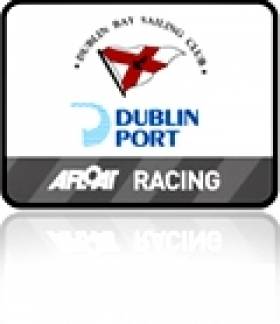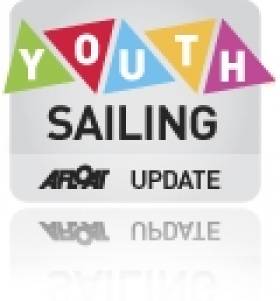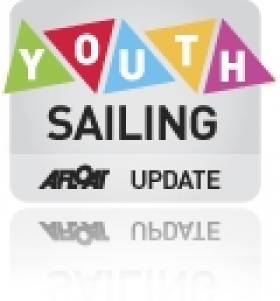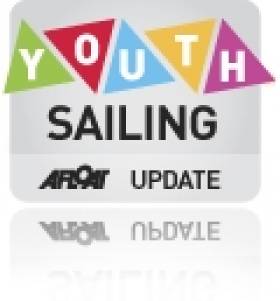Displaying items by tag: Laser
New Sponsor for Cork Laser Frostbites
Racing Update: World Team Racing, Lasers, Fevas, Fireballs, DBSC, Cruiser Challenge
All the weekend sailing news is wrapped up in a number of posts on Afloat.ie this morning: Schull Welcomes World Team Racers, Espey Wins Lasers, Local Sailor Takes Radials at Lough Derg Nationals, Howth Juniors Win 19-Boat Greystones Feva Event, Royal Cork Celebrates 2011 with 'At Home' Regatta, Supernova to the Fore in DBSC Cruiser Challenge Event, McCartin and Kinsella are New Irish Fireball Champions, Kenefick Steers Chimp to Overall Win at Half Ton Classic Cup, Cork Week Changes Dates for 2012.
Sign up for our newletter coming later this morning!
Predictably Olympic campaigners were to the fore at the 2011 Irish Laser National Championships yesterday but host club Lough Derg Yacht Club in Dromineer, Co. Tipperary are celebrating the first time in thirty years that a Laser sailor has won a National Championship division at their home club.
Belfast Olympic campaigner James Espey came top of the combined 151 boat fleet but yesterday the local cheers were for Derg sailor, Eoin Keller won the Irish Laser Radial National Championships.

Eoin Keller with his parents Josephine and Pat, and LDYC Commodore Lucy Sanders. Photo: Geraldine Wisdom
Lough Derg Yacht Club hosted the Irish Laser National Championship from 25 to 28 August. A total of 151 sailors participated in the event. Sailors travelled from all over Ireland and the UK to race in the event. The Laser class has three rig categories according to the sail size: the 4.7 Lasers (48 boats), the Laser Radials (71 boats) and the Standard or full rigs (32 boats).
Hosting a National event for such a large fleet requires considerable organisation, both on and off the water. LDYC Sailing Secretary, Michael McCarney, said that the "seventy plus volunteers, helping out at the event, ensured four great days of racing". He said that the "wildly varying weather conditions provided quite a challenge for sailors and race management". He added that "events such as this help to promote tourism and the local economy of this scenic area".

Laser Racing starts on Lough Derg
The Principal Race Officer for the event was John Lefroy. He conducted the races from his boat the 'Phoenix', and managed to get ten races in very changeable weather conditions. Liam Moloney and his team managed the finishing line on his yacht, 'Synergy'. John Lefroy said that he was "very impressed with the mark laying and rescue", and added that "the sailors were well tired at the end of the four days as I set demanding courses. Competitors at this level want to be stretched at these events". Jack Bayly and Teresa Hassey collated and posted the race results promptly every day.
Club Manager Claire Toohey coordinated Safety and Rescue for the Championship. This is a vital task, and Claire's organisational skills were very much in evidence. Claire commented that her brief was made easier by "top notch, well-trained local rescue crew, who did a superb job in quite testing conditions".
Summing up at the prize-giving, LDYC Commodore Lucy Sanders said, "I was impressed by the number of members who gave of their time to help out, particularly the younger members, who are the future of this Club". She went on to praise the work of the shore crew, including P. Keller and his helpers who efficiently managed the launch and recovery of boats, and Anne Atkinson and her team, who ensured the visitors were looked after with the hospitality for which the Club is well known.
RESULTS Irish Laser National Championship 2011Laser 4.7
1st Seafra Guilfoyle - Royal Cork Yacht Club
2nd Cian Byrne - Royal Cork Yacht Club
3rd Eoin Curran – East Down Yacht
Laser Radial
1st Eoin Keller – Lough Derg Yacht Club
2nd Robbie Gilmore – Strangford Lough Yacht Club
3rd Finn Lynch – National Yacht Club
Standard Laser Sailors
1st James Espey – Royal Ulster Yacht Club
2nd Ryan Seaton – Carrickfergus Sailing Club
3rd Matthew O'Dowd – Royal St. George Yacht Club
Yacht Broker O'Leary Marks Return to DBSC Sailing with a Win
Ross O'Leary marked his return to Dublin Bay Sailing Club (DBSC) racing last night with a light air win in the PY/Laser class. The Dun Laoghaire based yacht broker has missed part of the dinghy season due to an ankle injury. Second home was Gary O'Hare. Full results for both DBSC Dinghy and Cruiser fleets are below:
DUBLIN PORT Dublin Bay Sailing Club Results for 23 AUGUST 2011
BENETEAU 31.7 - 1. Magic (D.O'Sullivan/D.Espey)
BENETEAU 31.7 - 1. Magic (D.O'Sullivan/D.Espey)
CRUISERS 2 - 1. Red Rhum (J Nicholson), 2. Free Spirit (John O'Reilly)
CRUISERS 3 - 1. Asterix (Counihan/Meredith/Bushell), 2. Upd8 (Whelan/McCabe/Carey)
Ensign - 1. NYC 2 (Helen Cooney)
FIREBALL - 1. Goodness Gracious (Louise McKenna), 2. Blind Squirrel (Frank Miller), 3. No Name (B McGuire)
IDRA 14 FOOT - 1. Dart (Pierre Long), 2. Doody (J.Fitzgerald/J.Byrne), 3. Dunmoanin (Frank Hamilton)
MERMAID - 1. Tiller Girl (J.O'Rourke), 2. Jill (P.Smith/P.Mangan), 3. Kim (D Cassidy)
PY CLASS - 1. Ross O'Leary (Laser), 2. Gary O'Hare (Laser), 3. P Keane (Laser 1)
La Rochelle Laser Results Show Progress
Promising results came young Irish sailors came from the World and European Laser Radial Youth Champs in La Rochelle that ended at the weekend. Wexford and the National Yacht Club's Philip Doran finished 11th in Worlds (8th in Euros). Blessingtonn's Finn Lynch finished 7th in the u17 Worlds (he was the only sailor born 1996 in the gold fleet).
There were 271 entries in the boys. 99 entries in the girls.
Quoile and the Royal St. George's Sophie Murphy finished 30th in the girls, a result that included a final race win. See how all the Irish did here.
Irish Youth Lasers Compete in La Rochelle
In La Rochelle, France Ross Vaughan lies 82nd in a fleet of 132 at the European Laser Radial Mens Championships. Over 300 Lasers started their World Championships off La Rochelle yesterday in sunshine, a 20-25 kn breeze and a big swell.
Vaughan is a former member of Ireland's ISA Academy Squad who are all competing at the youth radial championships that start tomorrow at the same venue.
The Squad will also be joined by Finn Lynch and Fionn Lyden who the ISA say are on 'a six month probation period for entry into the Academy'. The 147 Standard-Youth sailor fleet is split in three groups.
After the first days racing in the Mens competition Sam Meech NZL is leading followed by Martin Evans GBR (5/1) and Francebesco Marrai ITA (2/5). Follow here.
Chris Penny also competed in the Standard Youth World and European Championships and finished 44th in the Europeans and 64th in the Worlds.
Murphy Stays in Top Ten at Youth Worlds
In spite of two thirtieth places scored in today's penultimate rounds Irish sailor Sophie Murphy stays in the top ten of the ISAF Youth Worlds in Zadar, Croatia. The Royal St George Yacht Club and Quoile Yacht Club Laser single-hander struggled in day fives stronger breezes, the first of the competiton.
Murphy can stay top ten, an important target, if she has a good final race tomorrow morning.
420 duo Emma Geary from Royal Cork Yacht Club and Niamh Connolly from Baltimore Sailing Club were definitely back on form today having been hampered by yesterday's lighter winds. The girls relished the medium breeze today placing 10th and 6th respectively in their two races. They lie 18th overall.
Philip Doran of Courtown Sailing Club and the National Yacht Club caught up to 12th place during his first race of the day but lost out on the final downwind which saw him finishing in 22nd. He fared better in his second race sitting fifth for the duration until the final mark when he was yellow flagged, the penalty saw him finish ninth leaving him 15th overall.
Meanwhile, Maxime Mazard (FRA) and Giovanni Coccoluto (ITA) go into the final day of racing at the 41st ISAF Youth Sailing World Championship in Zadar, Croatia with just one point separating them in the Laser Radial Boys fleet.
The Frenchman, who has led for the majority of the week, finished 25th and seventh today and has seen his five point overnight lead reduced to a single point after Coccoluto came seventh in Race 10 before discarding his disqualification in Race 11.
The final race tomorrow will decide who takes the gold medal home for their nation and it should be a fascinating finale.
RYA Volvo Team GBR sailor Cameron Douglas shone in the breeze today finishing with a bullet and a second place, he said, “It was an awesome day. We had a bit of breeze for the first time this week so I’m very happy. It has been a really great event.”
Australia’s Matthew Wearn won the days other race but did not finish Race 11 and is down in 26th place and Žan-Luka Zelko is third on 114 points trailing Mazard by eight points.
In the Laser Radial Girls Erika Reineke (USA) also finished with a race win and a second place. The American, who is a full time member of US SAILING’s Team Alphagraphics, said, “I liked today a lot better. There was a little bit of breeze and there was some nice waves. I was pretty far away from the gold today, 19 points, and I think I caught up a bit. I’m just going to go out and try my hardest tomorrow and try to win.”
Tiril Bue regained the lead in the Radial Girls fleet after she was consistent in the breeze finishing third in Race 10 and fourth in Race 11. Overnight leader Paulina Czubachowska came through in 10th and 11th today and has dropped to third overall. Manami Doi (JPN) maintains her second place overall but just two points separate Doi, Czubachowska and Reineke so it should be an interesting climax.
And like the Laser Radial Boys it will be winner takes all between Veronica Fanciulli (ITA) and Siripon Kaewduang-Ngam (THA) with just one point separating the pair in the RS:X Girls. Fanciulli went 2-4 today and Kaewduang-Ngam finished third and recorded a bullet to pull the overnight deficit down to a single point. Naomi Cohen (ISR) is third on 32 points and Agnieszka Bilska (POL), who claimed the days other bullet, is fourth on 36 points.
With three bullets today Louis Giard has leapt into second place in the RS:X Boys on 36 points. But Cho Wonwoo (KOR) continues to lead and will take a six point advantage into the final day following three RS:X races today. The Korean finished 2-4-6 today. Spain’s Mateo Sanz had a minor dent in his scorecard today following a tenth place in Race 9 but bounced back with a third and second. He is third overall on 37 points.
Morgan Kiss and Christina Lewis (USA) closed the gap on 420 leaders Lara Vadlau and Tanja Frank (AUT) to four points ahead of the final day. The Americans finished 4-5 today compared to the Austrians 8-2. Nikole Barnes and Agustina Barbuto (ISV) retain their third place following two seventh place finishes today. Today’s race wins went to Carrie Smith and Ella Clark (AUS) and Maelenn Lamaitre and Aloise Retornaz (FRA).
2010 ISAF Youth Worlds gold medallist Jordi Xammer with new crew Alex Claville regained the lead in the 420 Boys following a tenth and fourth place finish. They lead Japan’s Daichi Mototsu and Yuki Hino by eleven points. Angus Galloway and Alexander Gough (AUS) stay in third place going into the final day and have a two point advantage over Guillaume Pirouelle and Valentin Sipan (AUS)
In the SL16 Brazil’s Martin Lowy and Kim Andrade take a 13 point lead into the final day after they came eighth twice today. And with a fleet of 14, the boys from Brazil will need to sail a steady race tomorrow to seal the deal. Nicolaj Bjornholt Christiansen and Daniel Bjornholt Christiansen (DEN) had a good day coming second and third and are second overall on 37 points. And Great Britain’s Rupert White and Nikola Boniface are third on 48 points.
Carlos Robles and Florian Trittel have an impressive 19 point lead ahead of the final day after a bullet and a sixth place finish in the 29er. The Spaniards have only finished out of the top six twice and with a string of consistent results it would be hard to bet against the Spaniards claiming gold. The race for second place is interesting with Max Deckers and Annette Duetz (NED) on 51 points, Antoine Screve and Max Agnese (USA) on 53 points and Josh Franklin and Lewis Brake (AUS) on 56 points. The days other race win went the way of France’s Gael Jaffrezic and Julien Bloyet who are down in eighth place.
One race in each fleet will take place tomorrow to decide the medals and racing begins at 12:00 local time.
Irish Laser Radial sailors Philip Doran and Sophie Murphy tackled unfavourable variable light wind conditions in Day 4 of the ISAF Youth Worlds in Zadar, Croatia to produce four top ten performances, results that move Murphy up three places to eighth overall and Doran into 16th with two days of racing left.
Doran of Courtown Sailing Club and the National Yacht Club maximised yesterday's rest day and returned to the water this morning with 'a fresh mind'. He had his best day of the championships so far with two fifth places in the two races sailed today. Doran now moved up ten places from 26th.
Northern Irish sailor Sophie Murphy from Quoile YC and the Royal St. George YC had a similarly successful day. She placed 7th in her first race and although lying in 28th place rounding the first mark during her second race she worked hard and climbed the 41 boat fleet to finish in 6th place. Sophie now lies eighth and significantly the only Irish sailor in the top ten overall.
420 girls Emma Geary from Royal Cork Yacht Club and Niamh Connolly from Baltimore Sailing Club who favour heavier conditions had a tougher day placing 25th and 22nd respectively in their two races but their 25th placing is discarded leaving them in 22nd overall.
Maxime Mazard (FRA) continues to lead the Laser Radial Boys despite having an off day at the 41st ISAF Youth Sailing World Championship in Zadar, Croatia.
Mazard finished 24th in Race 8 before discarding his 38th place finish in Race 9. Mazard's 12 point lead from the third day has been reduced to five with Giovanni Coccoluto hot on his heels on 79 points.
But Coccoluto also struggled in breezier conditions in Zadar posting a 21st and 19th place finish. Israel's Oz Adam recorded an eighth place finish in Race 8 but finished 42nd in Race 9 and after discarding his DNF in Race 5 he slips down to third overall on 83 points.
?an-Luka Zelko (SLO) moved into contention for a medal today after claiming a bullet in Race 8 and coming tenth in Race 9 to sit fourth on 91 points. The Race 9 bullet went the way of ISAF Athlete Participation Programme sailor Ramon Gonzalez (PUR). The Puerto Rican sailor has 144 points to his name and is 17th overall.
In the Laser Radial Girls Poland's Paulina Czubachowska continues to lead the way on 50 points after nine races. But surprisingly she picked up her first bullet in Race 9 after posting an 18th place finish in Race 8. But the Polish sailor has shown consistency which has been key.
Manami Doi (JPN), in second, had a good day finishing 3-5 and moves into second place on 54 points. And Tiril Bue (NOR) had a better day following a bullet in Race 8 and a third place finish in Race 9. The Norwegian is third on 57 points.
The top of the 420 Girls is very tight with just six points separating the top three with three races remaining. Lara Vadlau and Tanja Frank (AUT) continue to lead the way after finishing with a bullet and third place today. But America's Morgan Kiss and Christina Lewis traded blows after the Austrians posted the same race results. But the Austrians are at the top of the leader board on 17 points with the Americans five points behind. Nikole Barnes and Agustina Barbuto trail the Austrians by six points in third.
Martin Lowy and Kim Andrade continued their dominance in the SL16 by winning their eighth consecutive race in a row. With eight points they have a gigantic 26 point lead with three races remaining in the championship. The Brazilians are in great form and with a huge lead the gold medal is almost theirs. The rest of the fleet will fight it out for the bronze and silver. Just nine points separate second and seventh place so it should be an interesting climax.
Spain's Carlos Robles and Florian Trittel have extended their lead in the 29er to 12 points after finishing fifth and fourth in today's racing. Australia's Josh Franklin and Lewis Brake had a consistent day finishing second in both races to move up to second overall. Antoine Screve and Max Agnese (USA) finished sixth and recorded a bullet in Race 9 to retain third place.The top of the RS:X Boys and Girls is looking interesting with just one point separating Veronica Fanciulli (ITA) and Siripon Kaewduang-Ngam (THA) in the Girls fleet. And four points split Cho Wonwoo (KOR) and Mateo Sanz (ESP) in the Boys.
Fanciulli finished 3-4 today to move onto 15 points and Kaewduang-Ngam came second in Race 7 before discarding her fifth place finish in Race 8. Naomi Cohen won Race 8 today and is second on 22 points. Agnieszka Bilska won the days other race and is fourth on 28 points.
And in the RS:X Boys Cho Wonwoo once again put in a consistent display out on the water. He came seventh in Race 7 and second in Race 8. He leads on 18 points. Sanz discarded his 13th place in Race 7 before bouncing back with a fourth in Race 8. The Spaniard is second on 22 points.
Sam Sills (GBR) won Race 7 today and is sixth overall on 55 points and the days other race win went to Pawel Tarnowski (POL) who is third on 30 points.
The 420 Boys are still out on the race course for their third race of the day.
Racing is set to commence at 12:00 local time tomorrow with two races scheduled in each fleet.
Racing Round Up: Lasers, E Boats, Puppeteers,DBSC, VDLR, Royal Cork, Cove and Sailor of the Month
In Cork Harbour 'Mid-Summer Madness' regatta attracted 40 Boats. We have the photos. There was a Fun Time for Cruisers at Cove Sailing Club's 'At Home' Regatta.
Galway's Martin Breen is June's Sailor of the Month and the Waterford Tall Ships Parade of Sail Photos are here.
Reasons to be cheerful? You bet. Click here to read how Dublin Bay sailors celebrate these wins.
In his first event sailing in the full rig boat Rush Sailing Club's Alan Ruigrock won the Laser Leinster Championships at the Royal St. George Yacht Club yesterday in some of the finest sailing conditions of the summer so far.
In a combined fleet of 110 boats and southerly winds of 10-15 knots, Ruigrock beat Howth's Ronan Cull and the host club's Conor Byrne who finished second and third respectively.
Annalise Murphy lived up to her billing as top Radial sailor in the country when, in a mixed 40 boat division, she beat Tiffany Brien for the Leinster title. In third place was next week's Irish Youth world's representative Philip Doran of Wexford.
The first 4.7 sailor was Royal Cork's Seafra Guilfoyle. The first master was Gareth Flannigan.
The following from the Class Association:
One hundred and ten sailors competed in the 2011 Laser Leinster Championships which were held in superb summer conditions on July 2nd & 3rd, and were hosted by the Royal St George Yacht Club. The weather did its part to show off Dublin Bay at its best with bright sunshine and a light sea breeze contributing to the regatta atmosphere for the sailors and their families alike.
The sailors needed to display all their skills to achieve a top end result. The wind peaked each day at 10 or 11 knots, with even pressure across the course and only a small number of wind shifts to take advantage of. Wind against tide meant the competitors needed good speed through the light chop. Equally important was a good start, made more difficult by the tide carrying the competitors over the line.
The principal race officer for the weekend was Con Murphy. At the prize giving, Con remarked that although he used a black flag for a number of the races it was great to see the high standard of the sailors meant that not a single person was OCS for the entire regatta.
Seafra Guilfoyle, with four bullets won the Laser 4.7 fleet, adding the Leinsters title to his Munsters and Ulsters trophies. John Durcan was 2nd and Cian Byrne third giving all three top spots to the Royal Cork Yacht Club. Emma Cooney from the NYC won the first lady prize.
The Laser Radial class is where many of Ireland's future Olympic hopefuls race and the Leinsters was no exception. Annalise Murphy of the NYC, "Afloat's May Sailor of the Month" and one of Ireland's strongest medal prospects in the 2012 Olympics won the event in compelling fashion with two firsts and three seconds. Tiffany Brien of Ballyholme YC, fresh from her recent Olympic campaign came in second. Philip Doran of Courtown YC claimed third prize. The prize for the first lady youth went to Sophie Murphy of the home club.
The Laser Standard fleet saw the most intense completion with the last race deciding all three top spots. On the Saturday, Ronan Cull clearly set himself apart winning all three races. At the end of the regatta only three points separated the leaders. Alan Ruigrok of Rush SC won the event, with Ronan Cull of HYC coming second and Conor Byrne claiming third prize for the RSGYC. Ballyholme yacht club also took home some silverware in this fleet with Oliver Loughhead taking the youth prize in fourth place overall and Gareth Flannigan taking the masters prize in 5th place.






































































